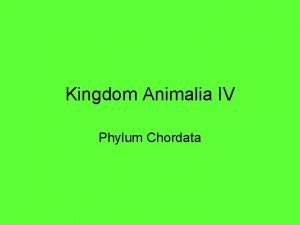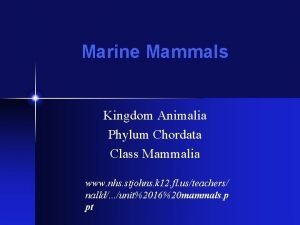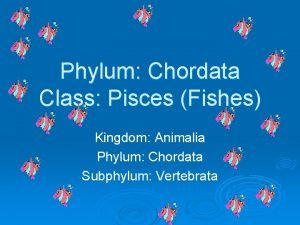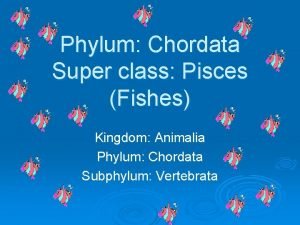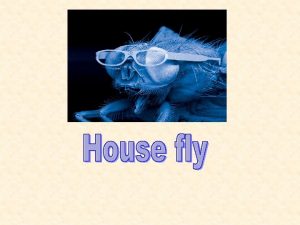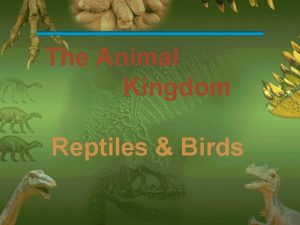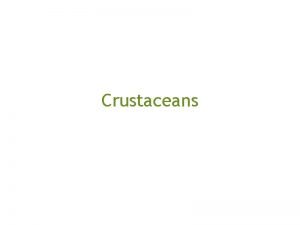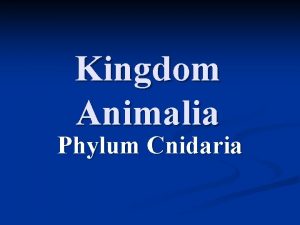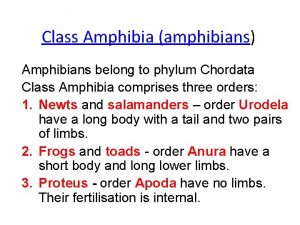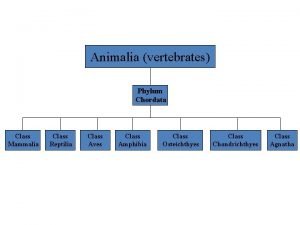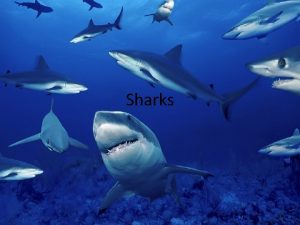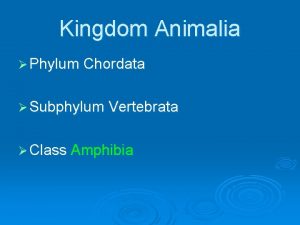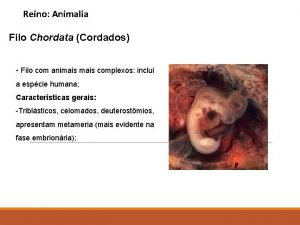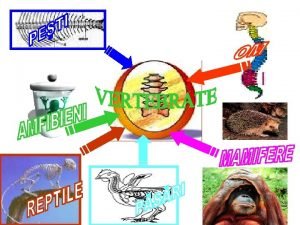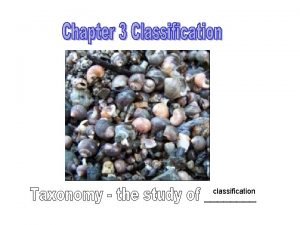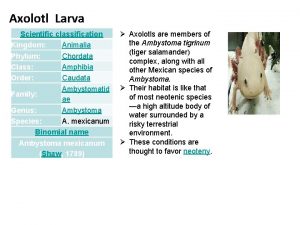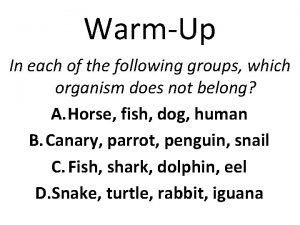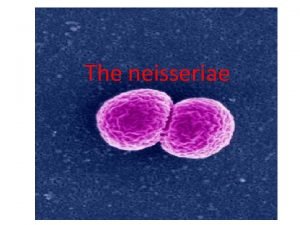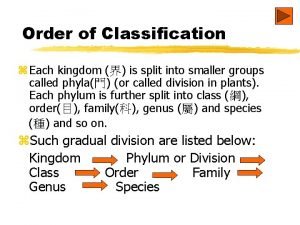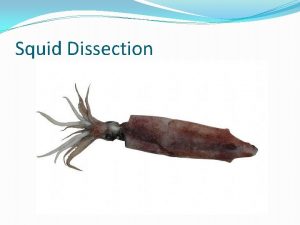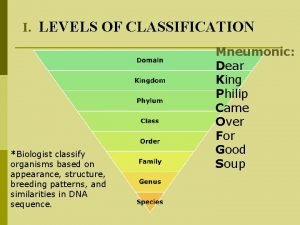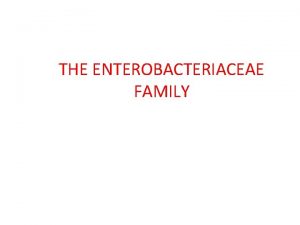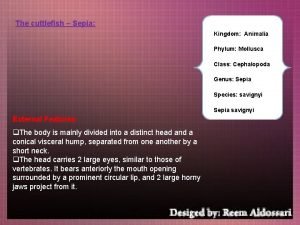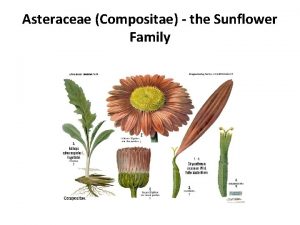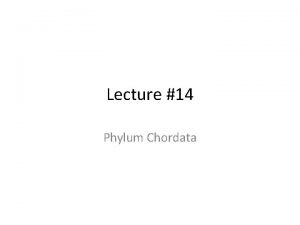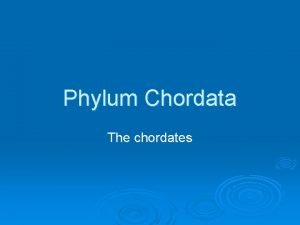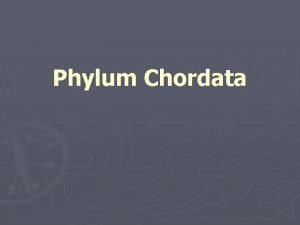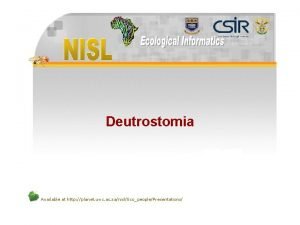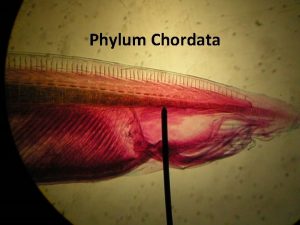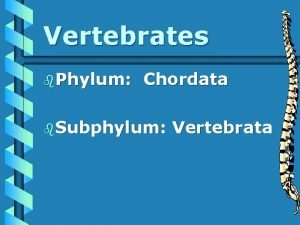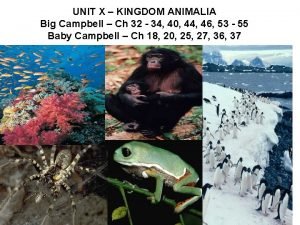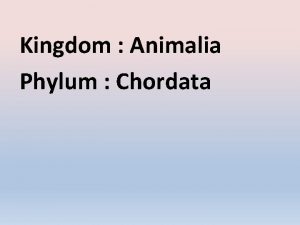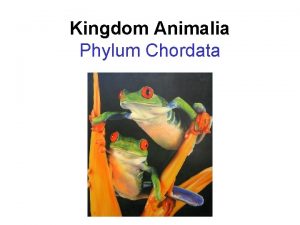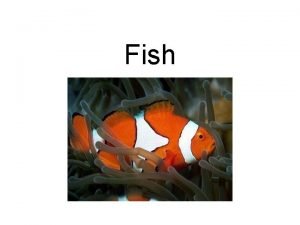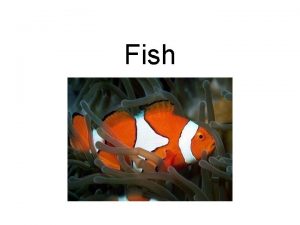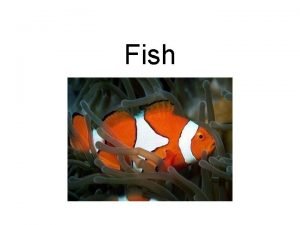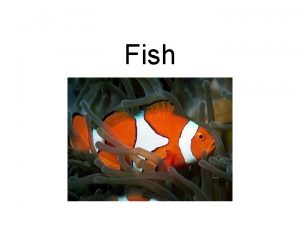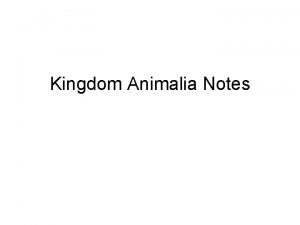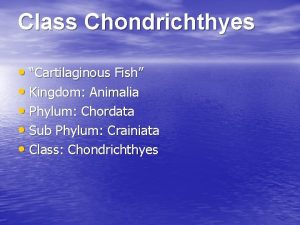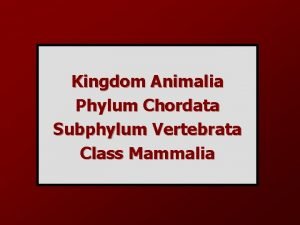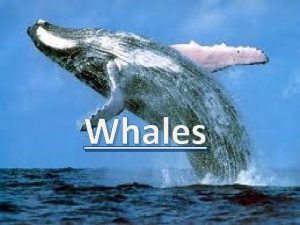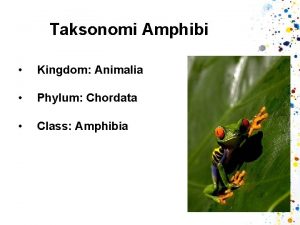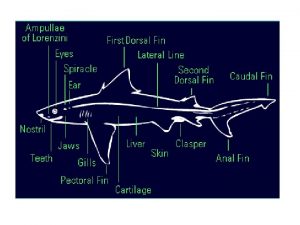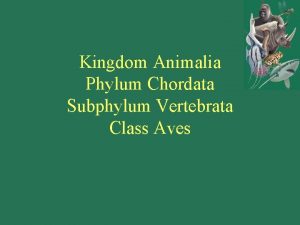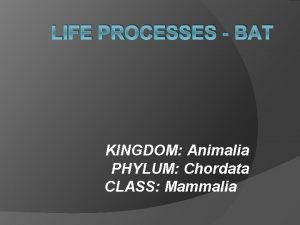Phylum Chordata Class Pisces Fishes Kingdom Animalia Phylum

























































- Slides: 57

Phylum: Chordata Class: Pisces (Fishes) Kingdom: Animalia Phylum: Chordata Subphylum: Vertebrata

Common Characteristics l l l l l 1. Vertebrate 2. Cranium - skull 3. Endoskeleton - bone or cartilage. 4. Streamline shape 5. Muscular Tail 6. Fins 7. Gills 8. Scales 9. Lateral Line – rows of sensory pores along the length of the fishes body that pick up vibrations in the surrounding water.

Ocean Sun Fish

Ocean Sun Fish

ØB. Classes Of Fishes 1. Agnatha – l Jawless l 2. Chondrichthyes – Cartilaginous l 3. Osteichthyes Boney l

Agnatha – Jawless fish Hagfish 1. Jawless l 2. Two Moveable plates l 3. Rough tongue used to pinch off chunks of flesh of another fish. l 4. Burrows through the body of dead fishes through gills or anus, eating all the internal parts. l 5. Releases a slime for defense




Lamprey Ø 1. Spend half it’s life free-living and half as a parasite. Ø 2. Uses it’s disk-shaped mouth with circular rows of sharp teeth to attach to a host and scraps a hole in the flesh, secreting a chemical that keeps the host blood from clotting and feeds on the blood or fluids that leak out. Ø 3. External fertilization




ØChondrichthyes

B. Chondrichthyes – cartilaginous fishes 1. Sharks teeth – Rows of teeth, shape and size depends of it’s feeding habit and what kind of species it is.





Megalodon Shark


Sharks Ø 3. Olfactory Bulbs – In the brain region that intercepts smell. Ø 4. Shark Skeleton – made of Cartilage. Ø 2. Placoids - Plate-like scales , tooth like spines, Very sharp and jagged edges

Chondrichthyes Ø 1. Rays Ø 2. Skates Ø 3. Sharks

Rays

Skates

Mako Hammer head Sharks TIGER LEMON Great White BULL

6. Gills – a sharks gills are not covered by an operculum, gills are exposed by gill slits. Sharks lack an operculum but they can still remain still because of the structures on their gills that allows water to constantly flow over them.

Sharks gills fully exposed



Ø 7. Rectal Gland – remove excess sodium and chloride ions from the blood and releases them in to the rectum for elimination. (urine)

Ø 1. Internal Fertilization A. Claspers – Males modified pelvic fins and used to transfer sperm into the females body. l B. Some of the fertilized eggs are hatched outside the sharks body and some develop inside the females body. l C. No parental care l




Skate eggs sack


ØOsteichthyes

C. Osteichthyes – Bony fishes 2. sub-classes a. Ray-finned fishes – Fins have sharp pointed bones covered with skin. b. Fleshy-finned fishes - lobed 1) Lung fish – lunged fishes

2) Coelacanth – very primitive, the front fins are more limb–like appendage, than fin like. Thought to eventually use fin-limb like appendages to climb out of the water?


4. External Anatomy of a Boney fish A. Head, trunk and a tail region. Ø B. Operculum – Hard plate, opens at the rear, covers and protects the gills. Ø

Ø C. Fins l 1. Caudal – Tail, forward movement l 2. Dorsal – top, Pair, Defense l 3. Anal – below tail, steering l 4. Pelvic – below and behind head, NAVIGATOR l 5. Pectoral – side of the head region, stopping


D. Skin – Scales cover, protect, growth rings

5. Internal Anatomy Ø A. Digestive System – l 1. Mouth Pharynx, esophagus, stomach, intestines, anus l 2. Accessory organs • A. Liver – produces bile • B. Gall Bladder – stores bile • C. Pancreas – releases enzymes 3. Villi – projections in the intestines that increase the surface area for absorption.

Villi


6. Circulatory Ø 1. Closed system Ø 2. Fishes heart - 2 Chambers, - 1 Atrium and 1 Ventricle. Ø 3. 4 parts l a. Sinus Venosus, l b. Atrium, l c. Ventricle l d. Bulbus Arteriosus Ø 4. Blood Vessels




7. Respiratory and Excretory functions Ø A. Gills – each gills contains filaments where blood flows across. This arrangement is called COUNTER CURRENT, it allows more oxygen to diffuse. l Gill Rakers – attached to the gills and help prevent food particles from passing through the brachial clefts

Gill rakers Gill Filaments

Ø B. Kidneys – filter and dissolve chemical waste from the blood, carried to the urinary bladder.

8. Swim Bladder Ø A. Bladder that regulates gas for buoyancy in the fish. (Depth at which the fish swims)

 Entertoxemia
Entertoxemia What are chordates
What are chordates Seal phylum
Seal phylum Class pisces fishes
Class pisces fishes Phylum pisces
Phylum pisces Diptera phylum
Diptera phylum Animal kingdom phylum chordata
Animal kingdom phylum chordata Kingdom animalia phylum arthropoda
Kingdom animalia phylum arthropoda Phylum cnidaria diagram
Phylum cnidaria diagram Cnidaria characteristics
Cnidaria characteristics Phylum chordata class amphibia
Phylum chordata class amphibia Phylum chordata class reptilia
Phylum chordata class reptilia Phylum chordata class chondrichthyes
Phylum chordata class chondrichthyes Phylum chordata class amphibia
Phylum chordata class amphibia Reino cordados
Reino cordados Animalia chordata
Animalia chordata Old kingdom middle kingdom new kingdom
Old kingdom middle kingdom new kingdom Nnn ruled
Nnn ruled Old kingdom middle kingdom new kingdom
Old kingdom middle kingdom new kingdom Capital of egypt during the old kingdom
Capital of egypt during the old kingdom Family order genus species
Family order genus species Phylum order
Phylum order Domain, kingdom, phylum
Domain, kingdom, phylum Sugar maple phylum
Sugar maple phylum 8 levels of classification in order
8 levels of classification in order Horse taxonomy chart
Horse taxonomy chart Kingdom phylum class order of humans
Kingdom phylum class order of humans Biology
Biology 3 domain system of classification
3 domain system of classification Axolotl larva ka classification
Axolotl larva ka classification Angiospermophyta examples
Angiospermophyta examples Kpcofgs
Kpcofgs Kingdom order
Kingdom order Bacteria kingdom phylum class order
Bacteria kingdom phylum class order Stapyl
Stapyl Iucn red list
Iucn red list Platypus taxonomy chart
Platypus taxonomy chart Kingdom phylum class order family genus and species
Kingdom phylum class order family genus and species Fibrobacteria
Fibrobacteria The classification schemes of a fungus and a bacterium
The classification schemes of a fungus and a bacterium Squid kingdom
Squid kingdom Classification of cow from kingdom to species
Classification of cow from kingdom to species Which level of classification is the most specific?
Which level of classification is the most specific? Class gland doman
Class gland doman Sepia kingdom
Sepia kingdom Levels of classification domain
Levels of classification domain Compositeae
Compositeae Ikan sungut gada
Ikan sungut gada Class pisces characteristics ppt
Class pisces characteristics ppt Amphioxus characteristics
Amphioxus characteristics Mesonychids
Mesonychids Phylum chordata notochord
Phylum chordata notochord Common characteristics of chordates
Common characteristics of chordates Phylum chordata
Phylum chordata Mnemonic for phylum chordata
Mnemonic for phylum chordata Chordata
Chordata Characteristics of subphylum vertebrata
Characteristics of subphylum vertebrata Cotoderm
Cotoderm

